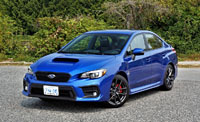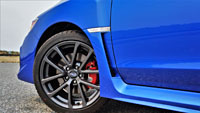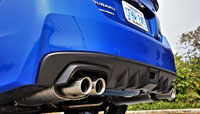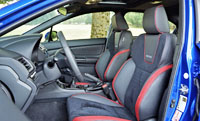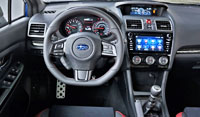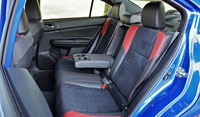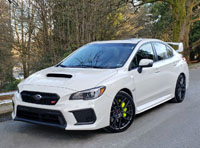
Do you prefer wing spoilers or lip spoilers? You’ll need to contemplate this before purchasing a new Subaru WRX STI. It might be an age thing, or the highest speed you plan on attaining. If you’ve got a racetrack nearby, I recommend the wing.
Being that my slow-paced home of Vancouver no longer has a decent racecourse within a day’s drive my thoughts are divided, because the massive aerodynamic appendage attached to this high-performance Subaru’s trunk adds a lot of rear downforce at high speeds, which it can easily achieve. Speed comes naturally to the STI. It’s rally-bred predecessor won the FIA-sanctioned World Rally Championship (WRC) three years in a row, after all, from 1995 to 1997, amassing 16 race wins and 33 podiums in total. That was a long time ago, of course, and Subaru has not contested a factory WRC team for more than ten years, but nevertheless the rally-inspired road car before you is much better than the production version tested in 2008.
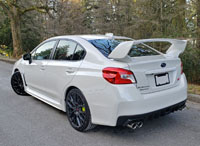
Rivals have come and gone over the years, the most disappointing loss being the Mitsubishi Lancer Evolution (EVO) that was discontinued at the close of 2015, while sport compact enthusiasts are no doubt lamenting the more recent cancellation of Ford’s Focus RS too, that car going away at the end of 2018 due to the death of the model’s less formidable trims. This said, the super compact category isn’t dead. Volkswagen revived its Golf R for 2016 and it’s still going strong, while Honda’s superb Civic Type R arrived on the scene for 2018, while Hyundai is getting frisky with its new Veloster N for 2020, although the last two mentioned don’t offer four-wheel drive so therefore don’t face off directly against their all-weather, multiple-terrain competitors.
The WRX STI seen here is a 2019 model, which means it hasn’t been updated with the new styling enhancements included for the 2020, but both get the 5-horsepower bump in performance introduced for 2018. To clarify, the regular WRX looks the same for 2020, at least from the outside, although its cabin gets some extra red stitching on the door trim plus its engine bay comes filled with a retuned 2.0-litre four, while the differential receives some revisions as well. This means only the STI receives styling tweaks, which include a new lower front fascia and new 19-inch aluminum machined alloy wheels for Sport and Sport-tech trims. The 2020 WRX STI Sport also receives proximity keyless access with pushbutton start/stop.
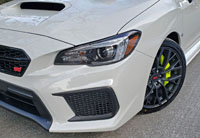
My 2019 WRX STI tester was in Sport trim, which fits between the base and top-line Sport-tech models. The base STI starts at $40,195 plus freight and fees, with the Sport starting at $42,495 and the more luxury-trimmed Sport-tech at $47,295. And by the way, the wing spoiler is standard with the Sport and Sport-tech, but can be swapped out for the previously noted lip spoiler when moving up to the Sport-tech at no extra charge.
Pickings are slim for a 2019 model, but I poured over Canada’s Subaru dealer websites and found a number of them still available. Just the same, don’t expect to find the exact trim, option and/or colour you want. At least you’ll get a deal if choosing a 2019, with our 2019 Subaru WRX Canada Prices page showing up to $2,500 in additional incentives available at the time of writing. Check it out, plus peruse a full list of trim, package and option pricing for both WRX and WRX STI models, as well as information about special financing and leasing offers, notices about manufacturer rebates, and most important of all, dealer invoice pricing could help you save thousands. This said if you can’t locate the 2019 model you want, take a look at our 2020 Subaru WRX Canada Prices page that’s showing up to $750 in additional incentives.
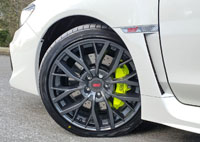
While the 2019 WRX STI looks no different than the 2018, it remains an aggressively attractive sport sedan. The 2018 STI added a fresh set of LED headlamps for a more sophistication appearance along with better nighttime visibility, while a standard set of cross-drilled Brembo brakes feature yellow-green-painted six-piston front calipers and two-piston rear calipers aided via four-channel, four-sensor and g-load sensor-equipped Super Sport ABS.
Subaru also revised the STI’s configurable centre differential (DCCD) so that it’s no longer a hybrid mechanical design with electronic centre limited-slip differential control, but instead an electric design for quicker, smoother operation, while the car’s cabin now included red seatbelts that, like everything else, move directly into the 2019 model year.
The STI’s interior also features a fabulous looking set of red on black partial-leather and ultrasuede Sport seats, with the same plush suede-like material applied to each door insert, along with stylish red stitching that extends to the armrests as well, while that red thread also rings the inside of the leather-wrapped sport steering wheel, the padded leather-like centre console edges, and the sides of the front seat bolsters. Recaro is responsible for the front seats, thus they are as close to racecar-specification as most would want from a car that will likely get regular daily use. The driver’s is 10-way power-adjustable, including two-way lumbar support, and superbly comfortable.
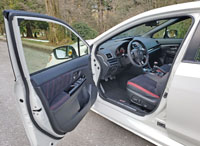
The rear passenger area is roomy and supportive as well, and impressively is finished to the same standards as the front, even including soft-touch door uppers. Additionally, Subaru added a folding armrest in the middle for the 2018 model year, with the usual dual cupholders integrated within.
If you want a reason why both WRX models sell a lot better than the arguably more attractive BRZ (at least the latter is sleeker and more ground-hugging), it’s that just-noted rear passenger compartment. The BRZ seats four, in a literal 2+2 pinch, but the WRX does so in roomy comfort. It has the rare pedigree of being a legendary sports car, yet provides the everyday usability of a practical sedan. Its 340-litre trunk is fairly roomy too, while the car’s rear seat folds down 60/40 via pull-tab latches on the tops of the seatbacks.
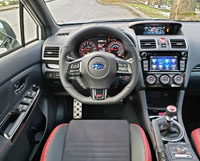
Additionally, all passengers continue to benefit from less interior noise, plus a retuned suspension with a more comfortable ride, while the WRX was given a heavier duty battery last year as well, plus revised interior door trim. What’s more, a new electroluminescent primary instrument cluster integrated a high-resolution colour TFT Multi-mode Vehicle Dynamics Control display, providing an eco-gauge, driving time information, a digital speedo, a gear selection readout, cruise control details, an odometer, trip meter, SI-Drive (Subaru Intelligent Drive) indicators, and the Driver Control Centre Differential (DCCD) system’s front and rear power bias graphic, whereas the 5.9-inch colour multi-information display atop the dash was also updated last year, showing average fuel economy, DCCD graphics, a digital PSI boost gauge, etcetera.
Subaru’s electronic interfaces have been getting steady updates in recent years, to the point they’re now some of the more impressive in the industry. The STI’s two touchscreens are as good as they’ve ever been, but compared to the gigantic vertical touchscreen in the new 2020 Outback and Legacy they look small and outdated. The base 6.5-inch screen in this 2019, in fact, which carries over to the 2020, shouldn’t even be available anymore, at least in a car that starts above $40k. In its place, the top-tier Sport-tech’s 7.0-inch touchscreen should be standard at the very least. Navigation doesn’t need to be included at the entry price, but one would think that one good centre display would make better sense economically than building two for such a niche model. Either way, both feature bright, glossy touchscreens with deep contrasts and rich colours.

The standard infotainment system found in my tester came with Apple CarPlay, Android Auto, and Subaru’s own StarLink smartphone integration, which also includes Aha radio and the capability of downloading yet more apps. I like the look and functionality of the current interface too, which features colourful smartphone/tablet-style graphics on a night sky-like blue 3D tiled background, while additional features for 2019 include near-field communication (NFC) phone connectivity, a Micro SD card slot, HD radio, new gloss-black topped audio knobs, plus more. My Sport tester can only be had with the base six-speaker audio system too, which had me missing the Sport-tech’s nine-speaker 320-watt Harman/Kardon upgrade, but I have say I would’ve been content with the entry sound system if I’d never tried the H/K unit.
Together with everything mentioned already, all three STI trims include a gloss black front grille insert, brushed aluminum door sills with STI branding, carpeted floor mats with red embroidered STI logos, aluminum sport pedals, a leather-clad handbrake lever, black and red leather/ultrasuede upholstery, two-zone auto HVAC, a reverse camera with active guidelines, voice activation, Bluetooth phone connectivity with streaming audio, AM/FM/MP3/WMA audio, vehicle-speed-sensitive volume control, Radio Data System, satellite radio, USB and auxiliary plugs, etcetera.
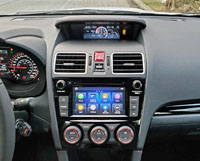
The STI gets a number of standard performance upgrades as well, like quick-ratio rack and pinion steering, inverted KYB front MacPherson struts with forged aluminum lower suspension arms, performance suspension tuning, high-strength solid rubber engine mounts, a red powder-coated intake manifold, a close-ratio six-speed manual transmission, a Helical-type limited-slip front differential, a Torsen limited-slip rear diff, and more.
Additional Sport trim features include 19-inch dark gunmetal alloy wheels wrapped in 245/35R19 89W Yokohama Advan Sport V105 performance tires, the aforementioned high-profile rear spoiler, light- and wiper-activated automatic on/off headlights with welcome lighting, a power moonroof, Subaru’s Rear/Side Vehicle Detection System (SRVD) featuring blindspot detection, lane change assist, rear cross traffic alert, etcetera.
Finally, top-line Sport-tech features that have yet to be mentioned include proximity keyless entry with pushbutton start/stop, navigation, as well as SiriusXM Traffic and Travel Link with weather, sports and stocks information, while the Sport-tech’s Recaro sport seats only get eight power adjustments.
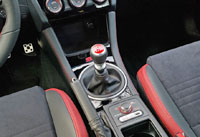
As is the case with all Subaru models, except the rear-drive BRZ sports car, the WRX STI comes standard with Symmetrical-AWD, the torque-vectoring system considered one of the best in the business. You can fling it sideways on dry or wet pavement, or for that matter on gravel, dirt, snow, or most any other road/trail surface, and remain confident it will pull you through, as long as it’s shod with the right tires for the occasion and your driving capability is at the level needed to correctly apply the steering, throttle and braking inputs as necessary.
As far as performance goes, the WRX STI is a car that is much more capable than most drivers will ever know, unless its deft poise saves them from an otherwise unavoidable accident. Its sporting prowess is legendary, and thanks to changes made a couple of years ago to the shifter and suspension, which made it much more enjoyable to drive in town as well as at the limit, it’s now an excellent daily driver. The manual transmission shifts smoother and easier, clicking into place with a more precise feel than in previous iterations.
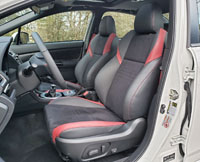
The upgraded six-speed manual takes power from a 2.5-litre turbo-four that received beefier pistons, a new air intake, new ECU programming, and a higher-flow exhaust system than the previous generation, resulting in an identical 290 lb-ft of torque and the 5 additional horsepower mentioned earlier, the STI now putting out 310. Additionally, the just-mentioned transmission gets a reworked third gear for a faster takeoff. Translated, the latest STI feels even more enthusiastic during acceleration than pre-2018 models, which were already very quick.
As always, the 2019 STI’s road-holding capability is fabulously good. It feels light and nimble, yet kept the rear wheels locked mostly in place through high-speed curves, whether the tarmac was smooth or strewn with dips and bumps. I only used the word “mostly” because it oversteers nicely when coaxed through particularly tight corners, like those often found on an autocross course. At such events braking is critical, so it’s good that the STI’s big binders noted earlier scrub off speed quickly, no doubt helped in equal measures by the Sport’s standard 245/35R19 Yokohama performance tires.
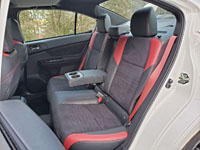
I can’t see fuel economy mattering much to the majority of STI buyers, but Transport Canada’s 2019 rating is reasonably efficient for a performance sedan just the same, at 14.1 L/100km city, 10.5 highway and 12.5 combined. Notably, these numbers haven’t change one bit from last year, while Subaru doesn’t show any advancements in the STI’s naught to 100km/h time either, once again claiming a sprint time that’s just 0.5 seconds faster than the regular WRX at 4.9 seconds. With only small adjustments made to its 1,550- to 1,600-kilogram curb weight (depending on trims), plus 5 additional horsepower now combined with a stronger third gear, both standstill and mid-range acceleration should be faster, which leaves me wondering whether Subaru is being conservative or if their marketing department merely hasn’t got around to updated the specs in their website.
So is the WRX STI for you? If you’re a driving enthusiast that still needs to stay real and practical, you should consider Subaru’s performance flagship. It’s well priced within the low- to mid-$40k range, and it’s an easy car to live with. Of course I can’t help but recommend it.
Story credit: Trevor Hofmann
Photo credits: Karen Tuggay

